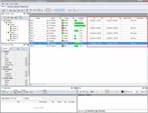|
1) How to understand the term “Critical Path” and what is CPM?
The Critical Path Method (CPM) is used for a project planning. The conception of the Critical Path simply means a sequence of tasks which form up a “backbone” of a project’s schedule: these tasks follow one-by-one on a project schedule and their total duration (sum of their durations) makes up the overall project duration predefining a project’s start and end dates, so if only one task residing on the Critical Path gets delayed, then automatically the entire project’s due date gets delayed too.
In other words, the project tasks lying on the Project Critical Path:
- Determine the end date in your project schedule;
- Once all of them are completed on-time, the entire project is completed on-time too;
- Don’t belong to the floating tasks which can be done earlier or later without any affecting the final date of the project;
- Can be even very small tasks, but always those affecting the duration of the project’s timeline;
- Should be estimated in the most accurate and realistic manner;
- If being somehow accelerated will make the project completed earlier;
Briefly, CPM is a technique to identify all the tasks which directly impact the project’s deadline and have a zero float (no possibility for leeway). Tasks which are not on the critical path are called slack or float as they can be moved within certain timeframes without changing the project’s timeframe. The project’s Critical Path determines the shortest possible time required to accomplish the project. CPM can help you to figure out:
- How long your project will take to complete;
- Which tasks are critical for the schedule (have to be done on time);
- Which tasks have a slack time (can float on the schedule);
2) Action Plan to determine the Critical Path:
- Get a detailed list of all tasks or activities required to complete the project (can be elaborated after you designed your project WBS);
- Give an accurate and realistic estimate on duration to every activity or task on the list;
- Determine the dependencies between the activities: define the predecessors and successors for every item on the list;
- Draw a network diagram including all the project activities and showing their dependencies;
- Determine the following four parameters for each activity:
- ES (the earliest start): the earliest time the task starts, defined by completion of previous tasks;
- EF (the earliest finish): the earliest start time plus the time required to complete the activity;
- LF (the latest finish): the latest time for the task completion without delaying the project;
- LS (the latest start): the latest finish time minus the time required to complete the activity;
- Determine the slack time for all activities. It is the amount of time between its earliest and latest start time (ES-LS), or between its earliest and latest finish time (EF-LF). Slack time is the time that an activity can be delayed past its earliest start (ES) or earliest finish (EF) without making the whole project late;
- Identify the critical path (the longest path through the project network diagram): make a path on the project network through tasks or activities which has zero slack (ES=LS and EF=LF);
- In shorter terms this can be formulated in such a way:
- Define the duration of each activity;
- Identify all the possible paths through the network diagram;
- Summarize the duration of each path;
- Define the longest path;
3) A simple way to organize a Project’s Critical Path with VIP Task Manager:
VIP Task Manager is a product that stands for collaboration between people in terms of projects and tasks, so it enables its users to plan and share the project’s Critical Path, including the project deliverables and embedded work packages comprising subtasks. Let’s consider simple step-by-step instructions to organize your Project’s Critical Path using this product:
Instruments to be used:
- Task Tree mode;
- Task List mode;
Task Tree mode actions (planning the Critical Path):
- Organize your task-oriented project structure at the Task Tree:
- Represent project deliverables and tasks of the highest level;
- Represent underlying work packages and included practical tasks;
- Create Custom Task Attribute:
- Date & Time Type: ES, EF, LF, LS;
 Duration type with formula: Slack on Start (ES-LS) and Slack on Finish (EF-LF); Duration type with formula: Slack on Start (ES-LS) and Slack on Finish (EF-LF);- List type “Critical Path” = Yes/No;
- Estimate all activities (tasks enclosed into each of the work packages) in terms of their ES, EF, LF, LS;
- Input the values into appropriate fields of every task and see the program calculating Slack for each of tasks;
- Tasks having ES=LS and EF=LF can be identified using he field “Critical Path” as “Yes”;
- Input results of the estimation by setting up the Start and Finish dates of specific tasks;
- If necessary can deactivate the fields ES, EF, LF, LS and Slacks;
Task List mode actions (review the Critical Path):
- Use Filters by the field “Critical Path” (set “Yes” value to screen out all the tasks residing on the Critical Path);
- Sort these tasks by their Start or Finish dates to see their order;
|